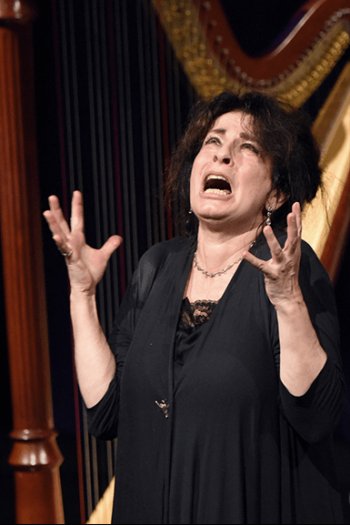Woman on a Ledge
A gifted storyteller and musician tells of an interesting and remarkable life.

Rita Costanzi in a scene from Hershey Felder’s “Woman on a Ledge” at Theater for the New City (Photo credit: David Behzadpour)
Woman on a Ledge is an adaptation by Hershey Felder of harpist Rita Costanzi’s writings about her life. Ms. Costanzi is a world-renowned harpist whose life experiences have been woven into a fascinating and highly engaging theater piece. As directed by Lissa Moira, this one-woman production beautifully integrates Ms. Costanzi’s superlative playing with her solid storytelling. One does not have to be a harpist or classical music fan to enjoy this production. Her storytelling alone is worth the time spent, and it becomes exceptional when coupled with her exquisite playing, used to underscore elements of her story.
The play begins with a discussion of someone named Mark.
Rita: “His name is Mark. Well, it’s really Marcos, but people call him Mark. It’s a plain name, but it works well for him.”
In a surprise twist of expectations for the audience, she tells them that Mark is a violin and describes “him” in terms that one would not expect to hear in the description of a violin.
Rita: “First of all…if you are a violin, you are meticulously crafted, with attention to detail and always with love despite the fact that what you are when all is said and done, is nothing more than a hollow wooden box.”
A sensual description of a violin follows, with phrases such as “long wonderful neck” and “a tailpiece.”
Rita: “Well, one helluva tailpiece if you’re Mark. And the sheen on you. It’s really something.”

Rita Costanzi as she appears in Hershey Felder’s “Woman on a Ledge” at Theater for the New City (Photo credit: Shelley and Keith Photography)
She speaks of a varnish so rich that it begs to be touched, and then the final piece, the chin rest. It is at this point that all of the descriptive buildup of the violin climaxes when she says,
Rita: “…you can put your chin on your chin rest, you will feel safe, you can raise your bow arm in a perfect arch, put a finger on the fingerboard, and…make the most beautiful music in the world. Two souls have come together. You and your violin.”
This opening continues with a description of her beloved harp, Maria, and then moves into the story of how she came to be consumed by music as a child. This whole opening sequence sets a musical and poetic tone for the show, with each moment having a lyrical quality underscored by interludes at her harp, Maria.
Costanzi tells of her father cutting out moons and stars when she was six and telling her that a magical fairy left them. Costanzi sits at her Maria and plays an excerpt from Debussy’s “Clair de Lune,” which beautifully underscores the elements of a story of magic and wonder. In this moment, she tells us of the impact it had on her life,
Rita: “The next morning he told me that a fairy had left them for me and they were magical moons and stars, that the moons and stars sing, and if ever I lose my way, just look up at the moon and stars—and there will always be music.”
This event will play a part in Costanzi’s life as she confronts difficult and sometimes painful issues. Looking up at the stars and hearing the music in the darkest moments helped her find a path through whatever challenges she faced.

Rita Costanzi in a scene from Hershey Felder’s “Woman on a Ledge” at Theater for the New City (Photo credit: David Behzadpour)
The story takes us through her extraordinary life as a musician, teacher, and, most importantly, mother. Motherhood gives her the biggest challenges. She married a man she met while attending the Eastman School of Music. He was a violinist, and they became an intense couple that led to marriage. Her parents did not approve of the marriage, but they accepted her decision. The one thing that hung over the relationship was the conflict between music and family.
She tells us of her feelings for her mother, who had given up her love of dancing to stay with her father and start a family. She sensed it as a burden her mother never was able to resolve. Now, as she is beginning to find success with her music, she explains that her Italian heritage, which put emphasis on having a family with children, was beginning to intrude in her life. An additional complication was the fact that she was becoming more successful than her husband.
Costanzi provides wonderful musical interludes as each of the critical events occurs in the story, with pieces that are beautifully integrated with the feelings associated with whatever event is being described. It is hard to convey in words how effective the blending of the words with the music is for an audience. It is an inclusive, almost mesmerizing experience.
The one area where the show needs to be reworked is in its length. There are moments depicting pensive introspection when the engaging flow of music and words begins to falter. These interludes could be dramatically shortened without disrupting the narrative and will shorten the play from an hour and forty-five minutes to a solidly engaging ninety minutes. Understand that this comment is not meant to diminish the show’s enjoyment. Woman on a Ledge is a wonderful show that deserves a much longer run. Rita Costanzi is a gifted storyteller an musician with an interesting and remarkable life story.
Lytza Colón’s set design is minimal but effective with a chair, a small table with a candle, a longer table with other objects, and the all-important harp, Maria. Lighting and sound design by Marsh Shugart gives solid support to the action, including moments of recorded sound effects. The musical excerpts are from Debussy, Tournier, Bach-Gounod, Puccini, Albinoni, Liszt, Paganini/Mchedelov, Kander and Ebb, and Traditional Irish and Scottish Folksongs
Woman on a Ledge (through November 24, 2024)
Theater for the New City
155 First Avenue, in Manhattan.
For tickets, visit https://ci.ovationtix.com/35441/production/1216026
Running time: one hour and 45 minutes without an intermission






Leave a comment